
Unlocking Security: Biometric Authentication’s Pros and Cons 

Is biometric authentication a silver bullet or a potential Achilles’ heel in the digital realm? Discover the answers here.
 Biometric Authentication in Cybersecurity: Balancing Pros and Cons
Biometric Authentication in Cybersecurity: Balancing Pros and Cons 

In the ever-evolving cybersecurity landscape, the need for robust and reliable authentication methods has never been greater. Traditional methods like passwords and PINs are vulnerable to breaches and attacks. This has led to the widespread adoption of biometric authentication, which relies on unique physical or behavioral traits for identity verification. While biometrics offer many advantages, they also come with their own set of challenges and concerns. In this article, we’ll explore the pros and cons of biometric authentication in cybersecurity.
Biometric Authentication: The Basics
Biometric authentication involves the use of unique biological or behavioral characteristics to verify a person’s identity. These traits are difficult for attackers to duplicate or steal, making them an appealing choice for secure access control. Here are some common biometric authentication methods:
- Fingerprint Recognition:
- Scanning and matching the unique patterns of ridges and valleys on a person’s fingertips.
- Facial Recognition:
- Analyzing facial features and comparing them to a database of known individuals.
- Iris or Retina Scans:
- Capturing and comparing the unique patterns in a person’s iris or retina.
- Voice Recognition:
- Analyzing vocal characteristics, including pitch, tone, and speech patterns.
- Palm Vein Recognition:
- Mapping the unique patterns of veins in a person’s palm.
- Behavioral Biometrics:
- Analyzing behavior patterns such as typing speed, mouse movements, and signature dynamics.
The Pros of Biometric Authentication
- Enhanced Security:
- Biometric traits are unique to each individual and are difficult to replicate or steal, making them highly secure. Attackers cannot guess, phish, or steal a biometric trait like they can with passwords or PINs.
- Convenience and Speed:
- Biometric authentication is incredibly convenient for users. It eliminates the need to remember and input complex passwords, saving time and reducing the risk of forgotten credentials.
- Reduced Password Fatigue:
- Users often struggle with password fatigue due to managing numerous accounts and complex passwords. Biometrics eliminates this burden, improving the overall user experience.
- Multifactor Authentication (MFA):
- Biometrics can complement other authentication methods, such as PINs or tokens, to create a robust MFA system that enhances security without sacrificing convenience.
- Increased User Adoption:
- Biometric authentication tends to have higher user adoption rates because it is intuitive and user-friendly. Users are more likely to embrace biometric security measures.
- Reduced Risk of Phishing:
- Phishing attacks often rely on tricking users into revealing their credentials. Biometrics are immune to such attacks since they cannot be stolen or phished.
- Improved Access Control:
- Biometrics are highly accurate, ensuring that only authorized individuals gain access to sensitive systems or data. Unauthorized access is significantly reduced.
The Cons of Biometric Authentication
- Privacy Concerns:
- The collection and storage of biometric data raise privacy concerns. Users worry about how their biometric data is used, stored, and potentially shared.
- Data Breaches:
- Biometric data, once compromised, cannot be changed like passwords. Users’ biometric information could be exposed in a data breach, leading to identity theft risks.
- Costs and Infrastructure:
- Implementing biometric authentication can be costly, requiring specialized hardware and software. Smaller organizations may find it challenging to invest in this technology.
- False Positives and Negatives:
- Biometric systems are not infallible and can produce false positives (incorrectly accepting unauthorized users) or false negatives (rejecting legitimate users). Accuracy is crucial.
- Spoofing and Attacks:
- Although difficult, biometric systems can be spoofed or tricked using various techniques, including fake fingerprints, photos, or voice recordings. Attackers continue to develop new methods.
- Single Point of Failure:
- Relying solely on biometric authentication can be risky. If a user’s biometric data is compromised, they may have no other means of access, leading to lockout scenarios.
- Cross-Device Compatibility:
- Biometric authentication methods may not be universally compatible across all devices and platforms, potentially limiting their usability. Compatibility issues can arise.
- Legal and Regulatory Issues:
- Compliance with data protection laws and regulations, such as GDPR, HIPAA, and CCPA, is challenging when handling biometric data. Failure to comply can result in legal issues.
Best Practices for Secure Biometric Authentication
While biometric authentication offers many advantages, its security depends on proper implementation and user awareness. Here are some best practices for secure biometric authentication:
- Protect Biometric Data:
- Safeguard biometric data with robust encryption both during transmission and storage. Ensure data is stored securely and is accessible only by authorized personnel.
- Implement Liveness Detection:
- Use liveness detection to differentiate between live biometric samples and non-living, spoofed samples. This helps prevent attacks using photos, recordings, or molds.
- Store Biometric Templates, Not Raw Data:
- Store templates derived from biometric data rather than the raw data itself. Templates are less susceptible to misuse and are more difficult to reverse-engineer.
- Continuous Monitoring:
- Implement continuous monitoring of biometric systems to detect anomalies or suspicious activity, such as repeated failed authentication attempts.
- Multi-Factor Authentication (MFA):
- Use biometrics as part of an MFA system that combines multiple authentication factors, such as something you know (password), something you have (smart card), and something you are (biometric trait).
- User Education:
- Educate users about the importance of biometric privacy and security. Encourage them to set strong passcodes or PINs for backup authentication methods.
- Regular Updates and Patches:
- Keep biometric authentication software and firmware up to date with the latest security patches and updates to address vulnerabilities and bugs.
- Transparency and Consent:
- Be transparent with users about how their biometric data is collected, stored, and used. Obtain clear consent before collecting such data.
Conclusion: Striking the Balance
Biometric authentication has emerged as a powerful tool in the realm of cybersecurity, offering enhanced security and user convenience. However, it has challenges and concerns regarding privacy and potential vulnerabilities.
Striking the right balance between the pros and cons of biometric authentication requires careful planning, robust security measures, and user education. By doing so, organizations can harness the power of biometrics while safeguarding user privacy and data. In the ever-evolving world of cybersecurity, finding this balance is key to a secure and user-friendly future.
Related Queries










Save/Share this story with QR CODE
Disclaimer
This article is for informational purposes only and does not constitute endorsement of any specific technologies or methodologies and financial advice or endorsement of any specific products or services.
 Need to get in touch?
Need to get in touch?

We appreciate your reading. 
1.) 

Your DONATION will be used to fund and maintain NEXTGENDAY.com
Subscribers in the Philippines can make donations to mobile number 0917 906 3081, thru GCash.
3.) 
4.) 
AFFILIATE PARTNERS

World Class Nutritional Supplements - Buy Highest Quality Products, Purest Most Healthy Ingredients, Direct to your Door! Up to 90% OFF.
Join LiveGood Today - A company created to satisfy the world's most demanding leaders and entrepreneurs, with the best compensation plan today.



 Business Technology, Finance Technology & Information Technology
Business Technology, Finance Technology & Information Technology




















































